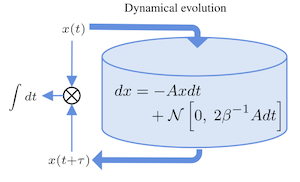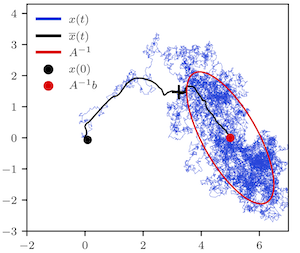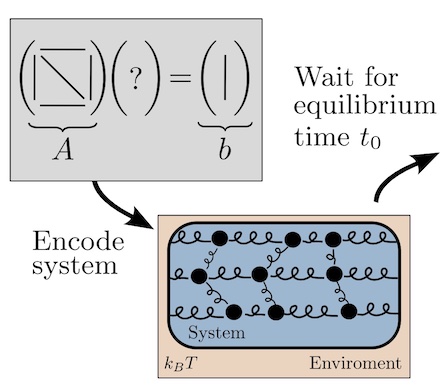Excursions in statistical dynamics
Excursions
in
Statistical Dynamics
by
Gavin Earl Crooks
A dissertation submitted in partial satisfaction of the
requirements for the degree of
Doctor of Philosophy
in
Chemistry
in the
GRADUATE DIVISION
UNIVERSITY of CALIFORNIA at BERKELEY
1999
[
Abstract |
Contents |
Supplemental |
Errata |
Full Text ]
Abstract
There are only a very few known relations in statistical dynamics that are valid for systems driven arbitrarily far away from equilibrium by an external perturbation. One of these is the fluctuation theorem, which places conditions on the entropy production probability distribution of nonequilibrium systems. Another recently discovered far-from-equilibrium expression relates nonequilibrium measurements of the work done on a system to equilibrium free energy differences. In contrast to linear response theory, these expressions are exact no matter the strength of the perturbation, or how far the system has been driven from equilibrium. In this work I show that these relations (and several other closely related results) can all be considered special cases of a single theorem. This expression is explicitly derived for discrete time and space Markovian dynamics, with the additional assumptions that the unperturbed dynamics preserve the appropriate equilibrium ensemble, and that the energy of the system remains finite.
These theoretical results indicate that the most interesting nonequilibrium phenomena will be observed during rare excursions of the system away from the stable states. However, direct simulation of the dynamics is inherently inefficient, since the majority of the computation time is taken watching small, uninteresting fluctuations about the stable states. Transition path sampling has been developed as a Monte Carlo algorithm to efficiently sample rare transitions between stable or metastable states in equilibrium systems. Here, the transition path sampling methodology is adapted to the efficient sampling of large fluctuations in nonequilibrium systems evolving according to Langevin’s equations of motion. Simulations are then used to study the behavior of the Maier-Stein system, an important model for a large class of nonequilibrium systems. Path sampling is also implemented for the kinetic Ising model, which is then employed to study surface induced evaporation.
Contents
-
Introduction
- Microscopic Reversibility
- Introduction
- Discrete time Markov chains
- Continuous-time Markov chains
- Continuous-time and space Markov processes
- Multiple baths with variable temperatures
- Langevin dynamics
- Summary
- Path Ensemble Averages
- Introduction
- Path ensemble averages
- Jarzynski nonequilibrium work relations
- Transient fluctuation theorem
- Kawasaki response and nonequilibrium distributions
- Summary
- The Fluctuation Theorem(s)
- Introduction
- The fluctuation theorem
- Two groups of applicable systems
- Long time approximations
- Summary
- Free Energies From Nonequilibrium Work Measurements
- Introduction
- Jarzynski nonequilibrium work relation
- Optimal computation time
- Bennett acceptance ratio method
- Response Theory
- Introduction
- Kawasaki response
- Nonequilibrium probability distributions
- Miscellaneous comments
- Path Ensemble Monte Carlo
- Introduction
- Path sampling Langevin dynamics
- Results
- Pathways to evaporation
- Introduction
- Path sampling the kinetic Ising model
- Surface induced evaporation
-
Postscript
-
Simulation of Langevin Dynamics
-
Bibliography
- Index
Supplemental
The following short programs demonstrate that path sampling can be used to study rare fluctuations in nonequilibrium Langevin dynamics. See Chapter 6, “Path Ensemble Monte Carlo”.
-
lmmmsNP.c - Standard simulation of the Maier-Stein nonequilibrium system.
-
lmmmsPS.c - Path sampling simulation of Maier-Stein nonequilibrium system.
-
duffingPS.c - Stocastic Path Sampling of a driven Duffing oscillator.
-
PathSampleDemoCode (13 K)




